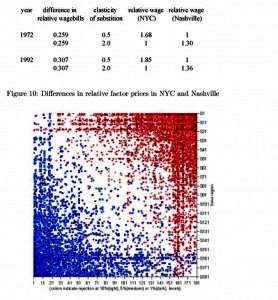We can now answer the question posed at the outset. Nashville and New York have significantly different relative wagebills for non-production and production workers, and thus significantly different relative wages. In fact, in 1972 the relative wagebill in Nashville is 11 percent below the US average while that for New York is 15% above. To map the estimated coefficients into differences in relative factor prices, we need to make assumptions about the elasticity of substitution. Figure 10 reports relative factor prices for the two labor markets with 1/ (1 — p) equal to 1/2 and 2 in 1972 and 1992. Nashville and New York do indeed have different exposure to external shocks as they have significantly different relative factor prices. With these elasticities, relative wages in New York and Nashville differ by 30%-85%. Left unresolved is whether the exposure comes through differences in their product mix or through differences in the factor intensity of production. In section 6, we examine whether variations in factor prices correspond to variations in industries across regions.
Our other test for relative factor price equality is the set of bivariate regressions in equation 28. However, there are far too many coefficients to report, 32580 in total for each year after allowing every region to be the base.19 Figure 11 shows the patterns of rejections for region-pairs in 1972. Darker shades indicate lower p-values. From the figure, we can see groups of regions with few rejections and groups with large numbers of rejections. In 1972, 21.4 percent of the region-pairs reject relative factor price equality at the 10 percent level, while 8.1 percent reject at the 5 percent level. Every region rejects with at least 8 other regions. In 1992, 30.0 percent of the region pairs reject relative factor price equality at the 10 percent level, 11.2 percent reject at the 5 percent level. Every region rejects with at least 10 other regions.
Both sets of results provide strong evidence against the single cone hypothesis for the US. Next we group regions into factor price cones.
Figure 11: Pairwise Regional Regressions – 1972

